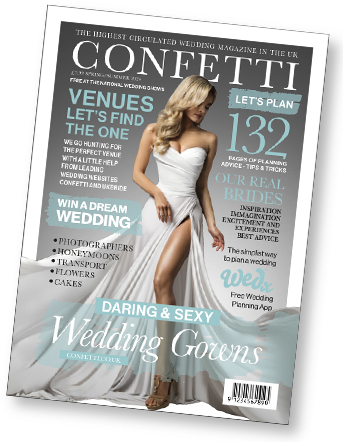Wedding piercings are more popular than ever. If you’ve thought about getting another piercing before your wedding day, you’re not alone. Bridal piercings and earring stacking on are on the up. Whether you’re thinking of adding another piercing to your ear or you’re intrigued about the dermal piercing trend, London ear and body piercing studio, Metal Morphosis answer all of your wedding piercing questions…
What’s the most popular location for piercings at the moment?
Always ears, earlobes are always the most popular – but over the last couple of years people are branching out to get more helix and conch piercings.
Is there a trend or uplift in requests for a certain type of piercing at the moment?
Clients are investing more in high quality internally threaded titanium pieces. This type of jewellery can work as a centre piece, or style up even the simplest piercing.

Are ear piercing guns safe and still used? Or are piercing needles the way to go?
Guns are still used, unfortunately, but they are the worst way to pierce. Guns are unhygienic, and cause additional trauma to tissue causing a multitude of problems and extended healing times. Piercing needles are the best way to pierce, and internally threaded or thread-less jewellery will provide the most optimal healing.
What are the different types of ear piercings?
Lots can be done on an ear, and there are adaptions to many of the existing ear piercings to give a unique look. Earlobes, Helix, Conch, Tragus, Anti-tragus, Rook, Forward Helix, Scaffold, Industrial, so many options!
A lot of brides are showing off multiple ear piercings on their wedding day. What’s the maximum number of piercings that you can have done in one day/one sitting if you want to get in on the multiple piercing trend quickly?
We do a maximum of three piercings in a session. For clients looking to create a feature look for an event we recommend selecting premium pieces that can heal well and give a beautiful look. Leave it at least 2 months before getting more, and keep in mind that you might need to wait a bit longer between sessions for piercings that need more time to heal.
What jewellery should they choose?
Titanium is by far the best metal to be pierced with. It is the most inert metal available, and is used for surgical implants. In regards to how to select a piece, use online references to plan the kind of look you want to achieve and show your piercer the kind go look you want to go for. Your piercer will be able to advise on the best thing to start with and can help you select the best option available.

What can you do if your piercing gets infected?
Try and get in to see your piercer asap. Sometimes a piercing can seem like it’s infected but is only irritated, and may need the jewellery lengthening to allow your body to heal the irritation. Additional cleaning may be needed to help the piercing settle, if it is infected your piercer can advise you what to do next and will tell you if you need to seek medical attention.
Some couples are opting for engagement piercings instead of engagement rings. Are finger piercings safe?
Finger piercings are not the safest of piercings. Our hands come into contact with bacteria and jewellery can catch and tear very easily, if you’re looking to mark an occasion with a piercing, established areas that are known to heal well are the better way to go- and investing in a nicer piece can act as a lovely memento.

Diamond dermal piercings are becoming increasingly popular with brides. What exactly is a dermal piercing?
A dermal piercing is a small piece of jewellery that anchors under the skin with a changeable attachment that sits flat on the surface on the skin. These piercings are preferable to surface bars on areas that are tricky to heal such as napes and cleavages as they are easier for the body to heal around. They also look great!
Can you get a dermal piercing anywhere on your body?
Unfortunately not, areas of high movement like wrists, collar bones, and lower backs are nearly impossible to heal, even with small dermals in and will almost always reject.
Is there a more popular area on the body for dermal piercings e.g. wrist/chest?
Centre cleavage, nape, surface tragus, and upper cheeks are the most popular areas for dermals and have the best chance of healing.
How long does a dermal piercing take to heal?
They can take up to six months to heal but most settle down in the two to four months. Dermal piercings always have the chance of rejection (growing out) and so I you feel like the dermal is moving closer to the surface of the skin its best to see your piercer so they can check it for you.
How long does a dermal piercing last?
Depending on the area, they can last anything from years to a couple of months. It’s really down to how well they settle initially and how well they are looked after.
Future piercing trend predictions?
Unique ear work! There’s so much you can do and adapt with ear piercings, choosing higher quality jewellery gives you a huge range of possibilities to change the look of existing piercings and change your vibe up just through jewellery.


